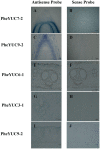New Insights Into the Local Auxin Biosynthesis and Its Effects on the Rapid Growth of Moso Bamboo (Phyllostachys edulis)
- PMID: 35592571
- PMCID: PMC9111533
- DOI: 10.3389/fpls.2022.858686
New Insights Into the Local Auxin Biosynthesis and Its Effects on the Rapid Growth of Moso Bamboo (Phyllostachys edulis)
Abstract
Auxin plays a crucial regulatory role in higher plants, but systematic studies on the location of auxin local biosynthesis are rare in bamboo and other graminaceous plants. We studied moso bamboo (Phyllostachys edulis), which can grow up to 1 m/day and serves as a reference species for bamboo and other fast-growing species. We selected young tissues such as root tips, shoot tips, young culm sheaths, sheath blades, and internode divisions for local auxin biosynthesis site analysis. IAA immunofluorescence localization revealed that auxin was similarly distributed in different stages of 50-cm and 300-cm bamboo shoots. Shoot tips had the highest auxin content, and it may be the main site of auxin biosynthesis in the early stage of rapid growth. A total of 22 key genes in the YUCCA family for auxin biosynthesis were identified by genome-wide identification, and these had obvious tissue-specific and spatio-temporal expression patterns. In situ hybridization analysis revealed that the localization of YUCCA genes was highly consistent with the distribution of auxin. Six major auxin synthesis genes, PheYUC3-1, PheYUC6-1, PheYUC6-3, PheYUC9-1, PheYUC9-2, and PheYUC7-3, were obtained that may have regulatory roles in auxin accumulation during moso bamboo growth. Culm sheaths were found to serve as the main local sites of auxin biosynthesis and the auxin required for internode elongation may be achieved mainly by auxin transport.
Keywords: YUCCA; auxin; culm sheaths; local biosynthesis; moso bamboo; rapid growth.
Copyright © 2022 Bai, Cai, Mu, Cheng, Zheng, Cheng, Li, Mu and Gao.
Conflict of interest statement
The authors declare that the research was conducted in the absence of any commercial or financial relationships that could be construed as a potential conflict of interest.
Figures






Similar articles
-
GA20ox Family Genes Mediate Gibberellin and Auxin Crosstalk in Moso bamboo (Phyllostachys edulis).Plants (Basel). 2023 Aug 1;12(15):2842. doi: 10.3390/plants12152842. Plants (Basel). 2023. PMID: 37570996 Free PMC article.
-
Genome-wide analysis and transcriptomic profiling of the auxin biosynthesis, transport and signaling family genes in moso bamboo (Phyllostachys heterocycla).BMC Genomics. 2017 Nov 13;18(1):870. doi: 10.1186/s12864-017-4250-0. BMC Genomics. 2017. PMID: 29132316 Free PMC article.
-
Systematic identification and expression pattern analysis of the Aux/IAA and ARF gene families in moso bamboo (Phyllostachys edulis).Plant Physiol Biochem. 2018 Sep;130:431-444. doi: 10.1016/j.plaphy.2018.07.033. Epub 2018 Jul 31. Plant Physiol Biochem. 2018. PMID: 30077919
-
Phytohormone Crosstalk of Cytokinin Biosynthesis and Signaling Family Genes in Moso Bamboo (Phyllostachys edulis).Int J Mol Sci. 2023 Jun 29;24(13):10863. doi: 10.3390/ijms241310863. Int J Mol Sci. 2023. PMID: 37446040 Free PMC article.
-
Transcriptomic Complexity of Culm Growth and Development in Different Types of Moso Bamboo.Int J Mol Sci. 2023 Apr 18;24(8):7425. doi: 10.3390/ijms24087425. Int J Mol Sci. 2023. PMID: 37108588 Free PMC article. Review.
Cited by
-
All-Year High IAA and ABA Contents in Rhizome Buds May Contribute to Natural Four-Season Shooting in Woody Bamboo Cephalostachyum pingbianense.Plants (Basel). 2024 Jan 30;13(3):410. doi: 10.3390/plants13030410. Plants (Basel). 2024. PMID: 38337943 Free PMC article.
-
Deciphering the Molecular Mechanism of the Intermediate Secondary Growth and Internode Elongation of the Castor Bean (Ricinus communis L.) by the Combined Analysis of the Transcriptome and Metabolome.Int J Mol Sci. 2024 Jan 15;25(2):1053. doi: 10.3390/ijms25021053. Int J Mol Sci. 2024. PMID: 38256130 Free PMC article.
-
Seasonal patterns of rhizosphere microorganisms suggest carbohydrate-degrading and nitrogen-fixing microbes contribute to the attribute of full-year shooting in woody bamboo Cephalostachyum pingbianense.Front Microbiol. 2022 Nov 29;13:1033293. doi: 10.3389/fmicb.2022.1033293. eCollection 2022. Front Microbiol. 2022. PMID: 36523824 Free PMC article.
-
Effect of Low Light Stress on Distribution of Auxin (Indole-3-acetic Acid) between Shoot and Roots and Development of Lateral Roots in Barley Plants.Biology (Basel). 2023 May 29;12(6):787. doi: 10.3390/biology12060787. Biology (Basel). 2023. PMID: 37372072 Free PMC article.
-
Uncovering PheCLE1 and PheCLE10 Promoting Root Development Based on Genome-Wide Analysis.Int J Mol Sci. 2024 Jun 29;25(13):7190. doi: 10.3390/ijms25137190. Int J Mol Sci. 2024. PMID: 39000298 Free PMC article.
References
LinkOut - more resources
Full Text Sources

